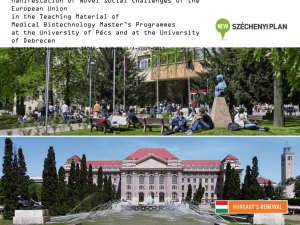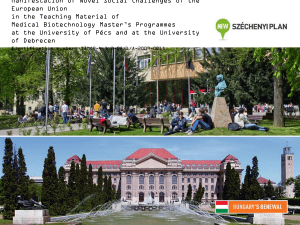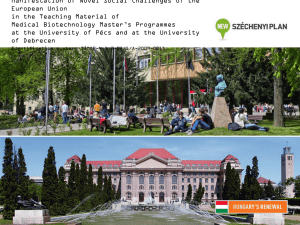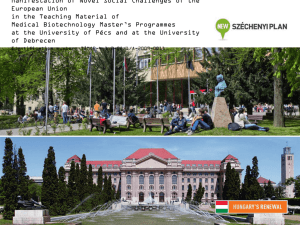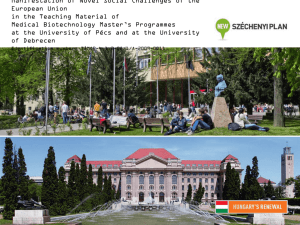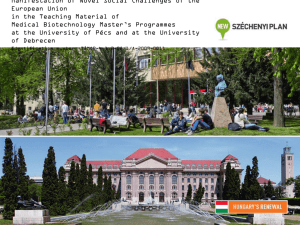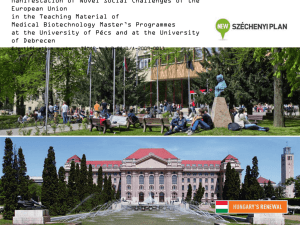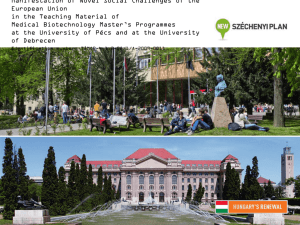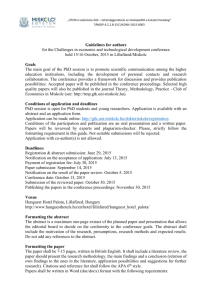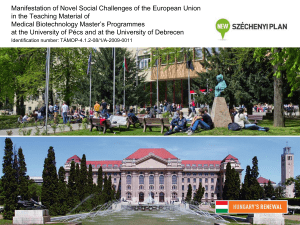Tissue repair
advertisement
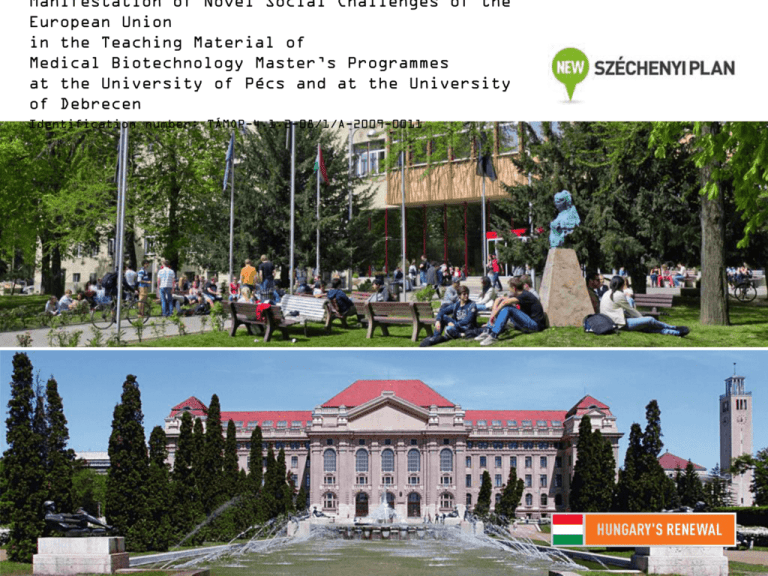
Manifestation of Novel Social Challenges of the European Union in the Teaching Material of Medical Biotechnology Master’s Programmes at the University of Pécs and at the University of Debrecen Identification number: TÁMOP-4.1.2-08/1/A-2009-0011 Manifestation of Novel Social Challenges of the European Union in the Teaching Material of Medical Biotechnology Master’s Programmes at the University of Pécs and at the University of Debrecen Identification number: TÁMOP-4.1.2-08/1/A-2009-0011 Dr. Judit Pongrácz Three dimensional tissue cultures and tissue engineering – Lecture 19 TISSUE REPAIR (3) TÁMOP-4.1.2-08/1/A-2009-0011 Heart failure • One of the most frequent conditions • Major cause of morbidity and mortality in developed countries • Causes: – Congenital malformations – Hypertension – Myocardial infarction – Toxic – Infectious TÁMOP-4.1.2-08/1/A-2009-0011 Heart regenerative therapies Heart regenerative therapies are in focus of investigation: • The occurence of heart failure (HF) is increasing with age • Population of developed countries are increasingly aged • Number of patients surviving myocardial infarction (MI) is increasing • Most of them have chronic HF (CHF) TÁMOP-4.1.2-08/1/A-2009-0011 Left ventricle assist device (LVAD) • Aids the pumping function of the (left) ventricle • Pulsatile pumping or • Continous pumping • Longest bearing of an implanted LVAD was 7 years TÁMOP-4.1.2-08/1/A-2009-0011 Ventricular assist devices In targets of heart transplantation: • Bridges the time until a donor is found • In itself enhances the regeneration of the damaged heart muscle • Improves life quality In patients not fitting for transplantation: • Palliative therapy • Improves life quality Complications may involve: • Risk of infection • Risk of clotting disorders • Risk of embolization TÁMOP-4.1.2-08/1/A-2009-0011 Bone marrow cells in cardiac repair Bone marrow Mesenchymal stem cells Hematopoietic stem cells SP cells Blood vessel Endothelial progenitor cells (hemangioblasts) Skeletal muscle Satellite cells SP cells Heart SP cells Kit+ cells Sca-1+ cells Fusion-dependent and fusion-independent differentation TÁMOP-4.1.2-08/1/A-2009-0011 Cellular therapies in cardiac repair I • Bone marrow cells (BMC) • Hemopoetic stem cells may contribute to heart repair • Extensively studied in animal models with variously labelled BMC • Sex-mismatched human heart transplant patients • After injury, homing to the injured region can be detected • GCSF mobilisation of BMC does not reproduce the results with injection TÁMOP-4.1.2-08/1/A-2009-0011 Cellular therapy of cardiac muscles Intravenous infusion Selective intracoronary infusion Direct intramyocardial injection Fusion with resident cardiomyocytes Differentiation to a cardiac phenotype ↓Cardiomyocyte apoptosis Recruitment of resident stem cells Cardiomyocyte proliferation Secretion of paracrine factors Matrix: Scar composition Granulation tissue ↑Number of functional cardiomyocyte s Differentiation to components of vascular wall Pro-angiogenic cytokines Angiogenic ligands ↑Perfusion ↑Cardiac performance Perivascular incorporation TÁMOP-4.1.2-08/1/A-2009-0011 Cellular therapies in cardiac repair II • No direct evidence of BMC transdifferentiation to cardiomyocytes • If it occurs, it is a rare event • Maybe the obviously present benefit is the increased vascularization of the injured heart muscle which enhances intrinsic regeneration capacity TÁMOP-4.1.2-08/1/A-2009-0011 Cellular therapies in cardiac repair III • Evidence for dividing cardiomyocytes in the human heart • Multyple types of proliferating cells in the myocardium was observed bearing both SC markers (Sca-1, CD31) and cardiomyocyte markers upon triggered injury (5-azacytidine) • Present in rodents and humans • Marked proliferative capacity TÁMOP-4.1.2-08/1/A-2009-0011 Cellular therapy of cardiac muscle Cardiomyocite Skeletal muscle • Single nuclei (central) • Gap junction (+) • Cx43 expression (+) • Multinucleated (peripher • Gap junction (-) • Cx43 expression (-) ??? Myotube Myoblast (satellite • Multinucleated • Gap junction (-) • Cx43 expression (-) • Single nucleus • Gap junction (+) • Cx43 expression (+) • Proliferation (+) Fusion and differentiation TÁMOP-4.1.2-08/1/A-2009-0011 Skeletal myoblasts • Early studies used cultured SMBs from muscle biopsies • Improvement of cardiac performance and life quality: – Reduced NO consumption – Improvement in NYHA class – Better excercise tolerance • Patients showed ventricular arhyithmias • Sometimes ICD use was necessary • However, the number of patients treated was low • No untreated control group was used in these TÁMOP-4.1.2-08/1/A-2009-0011 Embryonic stem cells • Cardiogenic potential is assured • Injury repair: hESC needed to be differentiated before application • Injury itself is not enough to trigger growth and functional replacement, moreover, inflammatory citokines damage the grafted cells • Anti-inflammatory treatment and protective agents needed for graft support (IGF-1, pancaspase inhibitors and NO blockers) • Differentiated cardiomyocytes trigger an immunoresponse in immunocompetent mice • Problem: teratoma risk! Translation to the TÁMOP-4.1.2-08/1/A-2009-0011 Tissue engineering in tooth regeneration/replacement • Dentition is important for feeding in vertebrates • Aberrations in dentition or poor dental care is not life-threatening in developed countries • But damage and loss of teeth may substantially affect quality of life TÁMOP-4.1.2-08/1/A-2009-0011 Tooth development • Reciprocal signaling events between the epithelium and underlying mesenchyme • Initiation, morphogenesis and terminal differentiation Crown Enamel Cementum Odontoblast Pulp Gingival fibe Periodontal membrane Sharpey fiber Root 1.Bud stage 2.Epithelial cup (Encloses the mesenchyme) 3.Bell stage Dentin Blood vessel Alveolar bone Neural fiber TÁMOP-4.1.2-08/1/A-2009-0011 Dental pulp stem cells (DPSC) • DPSC are multipotent cells in the dental pulp • Regeneration of dentin after tooth injury • Odontoblasts emerge close to the site of injury • Undifferentiated mesenchymal cells are constantly migrating from deeper tooth layers to the dentin differentiating into odontoblasts • Evidence suggest that these are DPSC TÁMOP-4.1.2-08/1/A-2009-0011 Differentiation capacity of DPSC • Human DPSC cultured under mineralization-enhancing conditions • Cells form odontoblast-like cells producing dentin and expressing nestin • DPSCs phenotypically resembles to MSC but its capacity to produce dentin is unique TÁMOP-4.1.2-08/1/A-2009-0011 Bioengineered tooth concepts Screening of tooth-forming cells 3D manipulation of single cells Transplantation of a bioengineered tooth germ Epithelial cells Patient derived stem cells Bioengineered tooth germ Mesenchymal cells Bioengineered tooth Bioengineered tooth, germ development prepared by in vitro culture Transplantation TÁMOP-4.1.2-08/1/A-2009-0011 De novo tooth engineering I Scaffold-based roots: • Bio-artificial root implant that supports an artificial (porcelain) crown • Cells grow inside the scaffold thus serving as a proper anchor • Animal (porcine) model proved the applicability of this solution TÁMOP-4.1.2-08/1/A-2009-0011 De novo tooth engineering II Reproduction of embryonic tooth germs: • Fully functional tooth by reproducing the embryonic tooth development • Both roots and crown are formed • Rodent experiments were successful • Not only embryonic or newborn cells but also adult cells were able to recreate tooth • Both scaffold and scaffoldless experiments Manifestation of Novel Social Challenges of the European Union in the Teaching Material of Medical Biotechnology Master’s Programmes at the University of Pécs and at the University of Debrecen Identification number: TÁMOP-4.1.2-08/1/A-2009-0011 Dr. Judit Pongrácz Three dimensional tissue cultures and tissue engineering – Lecture 20 TISSUE REPAIR (4) TÁMOP-4.1.2-08/1/A-2009-0011 Major causes of urogenital injuries Injuries or loss of function of the urogenital organs: • • • • Congenital malformations Trauma Infection, inflammation Iatrogenic injury TÁMOP-4.1.2-08/1/A-2009-0011 Repair possibilities of the urogenital organs Autologous nonurogenital tissues • Skin • Gastrointestinal segments • Mucosa from multiple body sites Allogen • Kidney graft for transplantation (cadaver or living) • Cadaver fascia Xenogenic materials • Bovine collagen Arteficial materials • Silicone • Polyurethane • Teflon TÁMOP-4.1.2-08/1/A-2009-0011 Obtaining cells for tissue regeneration • Autologous or allogenic • End stage organ damage restricts cell availability for tissue repair • In vitro culturing results are different – In vitro cultured bladder SMC: lower contractility • Low cell number may hinder possibilities • Stem cells can be the solution Biomaterials for genitourinary reconstruction I TÁMOP-4.1.2-08/1/A-2009-0011 • Arteficial materials • Replacement of ECM functions: – Providing 3D structure of tissue formation – Regulation and stimulation of cell differentiation via the storage and release of bioactive factors – Injecting cells without scaffold support is not effective Biomaterials for genitourinary reconstruction II TÁMOP-4.1.2-08/1/A-2009-0011 Naturally derived biomaterials: • Collagen • Alginate • Acellular tissue matrices: – Bladder submucosa – Small intestinal submucosa (SIS) Synthetic polymers: • PLA, PGA, PLGA TÁMOP-4.1.2-08/1/A-2009-0011 Uroepithel – unique features • Excretion not absorption • Recent methods favor intestinal autografts for urethra, ureter or bladder repair • The different structure and function of uroepithel and intestinal epithel often lead to complications which may be severe TÁMOP-4.1.2-08/1/A-2009-0011 Urethra reconstruction I Strictures, injuries, trauma, congenital abnormalities (hypospadiasis) Most often, buccal mucosa grafts are used for reconstruction: • Graft tissue is taken from the inner surface of the cheek or lips • The epithelium is thick and the submucosa is highly vascular • This graft is resistant for TÁMOP-4.1.2-08/1/A-2009-0011 Urethra reconstruction II Bladder-derived urothelium: • Suitable for reconstruction in rabbits • No human tests have been conducted Decellularized collagen matrices: • The material is available on-demand • Good results in „only” reconstructive surgery • Results in strictures when TÁMOP-4.1.2-08/1/A-2009-0011 Urethra reconstruction III Decellularized and tubularized matrices seeded with autologous urothelium: • Good results in animal models • Constructs seeded with cells developed similar histological structure to that of uroepithelium • Collagen matrices without cell seeding resulted in strictures TÁMOP-4.1.2-08/1/A-2009-0011 Bladder reconstruction I Most commonly intestinal-derived mucosal sheets are used for reconstruction: • Intestinal epithelium is different from urothelium • Designed to absorb and secrete mucus • Complications: infection, urolithiasis, metabolic disorders, perforation, increased mucus production, malignancies Because of disappointing results, attempts for alternative treatments are performed TÁMOP-4.1.2-08/1/A-2009-0011 Bladder reconstruction II Augmentation of bladder: • Progressive dilatation of native bladder tissue in animal experiments • Augmentation cystoplasty in animals and humans with dilated urethral segments • Better than the usage of GIT-derived segments TÁMOP-4.1.2-08/1/A-2009-0011 Bladder reconstruction III Non-seeded acellular matrices: • Xenogenic SIS → decellularized collagen-based tissue matrix → no musclular layer • Epithelization of the graft construct did occur • Non-compliance because of the lack of muscularis layer Matrices seeded with epithel and SMC: • Successful muscular layer formed, compliance is fair TÁMOP-4.1.2-08/1/A-2009-0011 Ureter reconstruction Animal studies for urether reconstruction: • Non-seeded matrices facilitated the re-growth of the urethral wall components in rats • Stiff tubes like teflon were unsuccessful in dogs • Non-seeded acellular matrices proved to be un-successful to replace a 3cm long urethral segment in dogs • Cell seeded biodegradable scaffolds TÁMOP-4.1.2-08/1/A-2009-0011 Kidney replacement therapy Currently two options are available for the treatment of end-stage renal failure (ESRF): • Dialysis • Kidney transplantation TÁMOP-4.1.2-08/1/A-2009-0011 Dialysis • Hemodialysis, hemofiltration – Extracorporeal dialyzer unit: hollow fiber dialyzers are most commonly used – Anticoagulated venous blood is let through the dialyzer, countercurrent of dialysis solution is applied • Peritoneal dialysis – Dialysis solution is applied in the peritoneal cavity • Toxic metabolites and excessive water are removed from the patient via osmotic differences between the blood and dialysis TÁMOP-4.1.2-08/1/A-2009-0011 Kidney transplantation • Most often transplanted parenchymal organ • Cadaver or live donor • Offers an improvement in the life quality of dialyzed patients • Implantation of allogenic grafts needs immunosuppressive treatment • Side effects of immunosuppressive agents involve increased risk of infections and malignancies, kidney and hepatotoxicity, cardiovascular and TÁMOP-4.1.2-08/1/A-2009-0011 Tissue engineered kidney Bioartificial approach: • Replace dialysis machines with bioartificial kidney • Extracorporeal devices/intracorporeal devices • Preclinical trials on dogs with porcine TE renal tubules: successful BUN and K control • However, the patient is still tied to an extracorporeal machine TÁMOP-4.1.2-08/1/A-2009-0011 Bioartificial kidney Heat exchanger Pump 2 5-7 ml/min Luminal space Proximal tubule cells 5-10 mm Hg Fiber wall RAD cartridge Ultrafiltrate reservoir Extracapillary space Pressure monitor 10-25 mm Hg Heat exchanger Ultrafiltrate into RAD luminal space) Hemofilter Post hemofilter blood (into RAD ECS) Processed ultrafiltrate (urine) Post RAD blood Replacement fluid Pump 3 70-80 ml/min Pump 1 80 ml/min Venous blood TÁMOP-4.1.2-08/1/A-2009-0011 Tissue engineered kidney In vivo approach: • Human kidney cells were seeded onto a polycarbonate tubular construct • Upon implantation in nude mice the construct was extensively vascularized • Urine-like fluid production: urea and creatinine content • Epithelial cells showed signs of tubular differentiation TÁMOP-4.1.2-08/1/A-2009-0011 In vitro engineered murine kidney Cells Bud Bud Wolff duct Cells Metanephric mesenchyme 4-6 days

